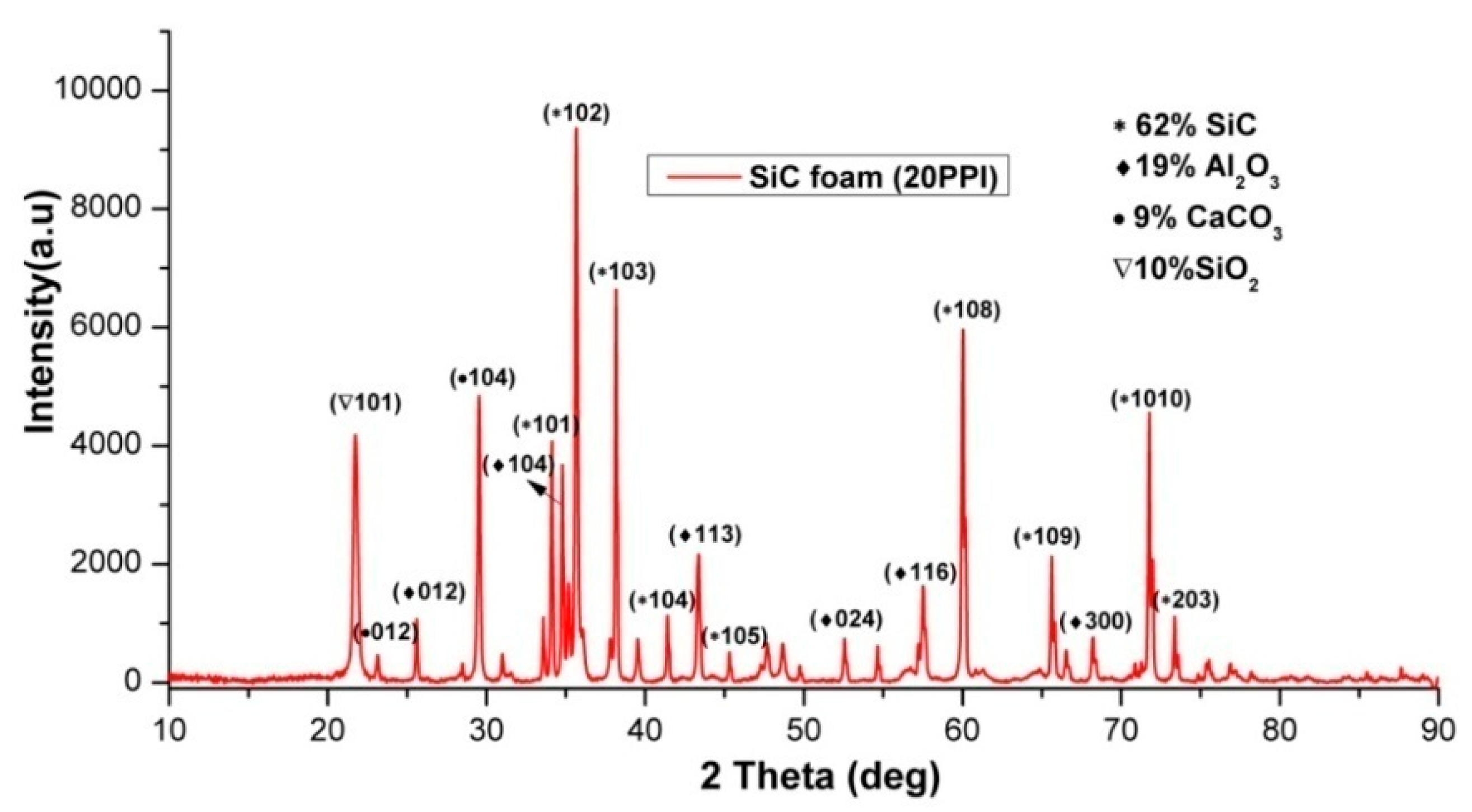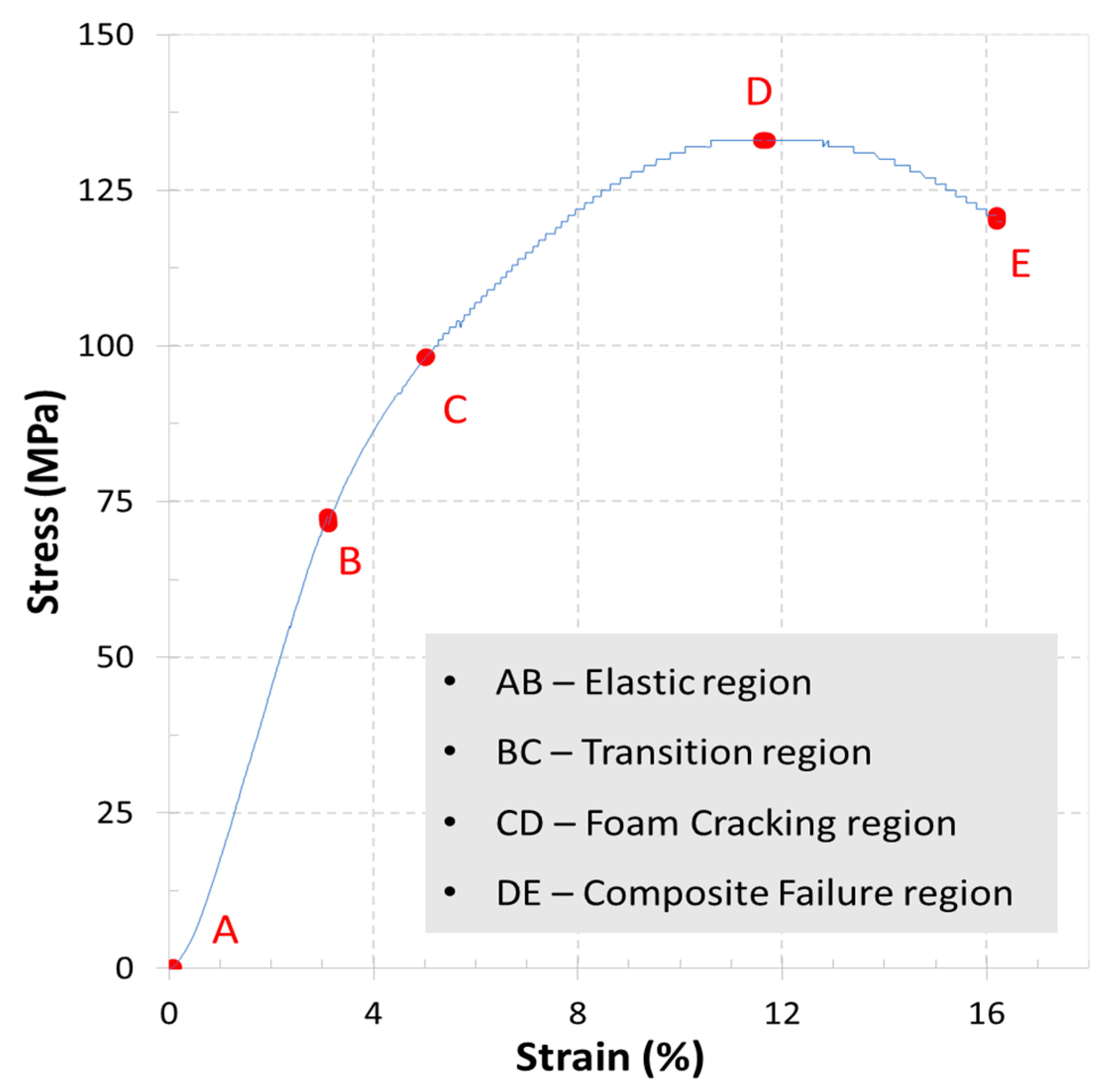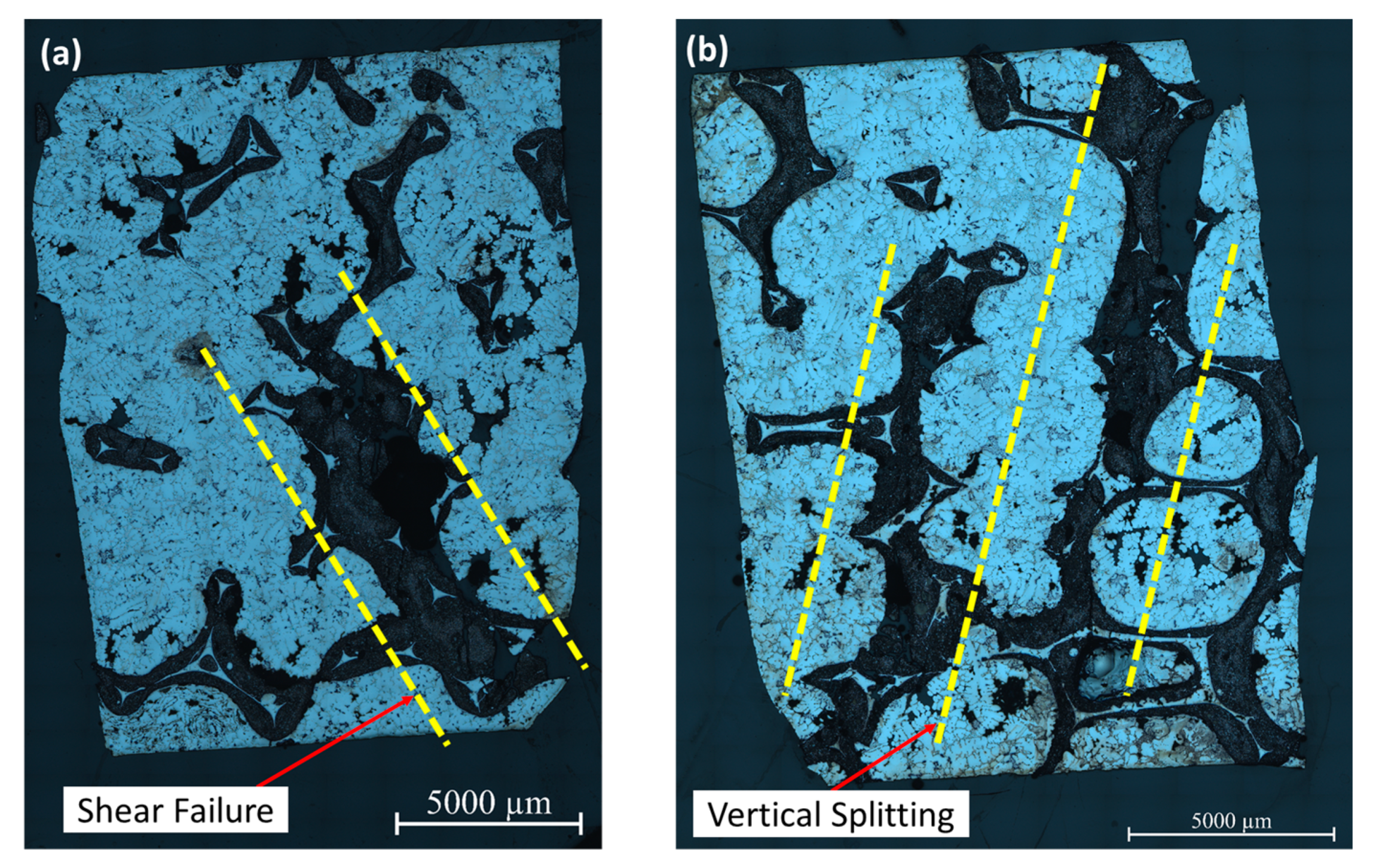Uniaxial Compressive Behavior of AA5083/SiC Co-Continuous Ceramic Composite Fabricated by Gas Pressure Infiltration for Armour Applications
Abstract
1. Introduction
2. Materials and Methods
2.1. Ceramic Foam
2.2. Infiltrant Alloy
2.3. Manufacturing of C4
2.4. Analyses of Microstructural Properties
2.5. Analyses of Mechanical Properties
3. Results and Discussion
3.1. Metallographic Analysis of SiC Foams
3.2. Porosity and Structural Analysis of SiC Foams
3.3. Microstructural Analysis of C4
3.4. Mechanical Property Analysis
3.5. Compressive Behavior of C4
3.6. Fractography Analysis
3.7. Microstructure of Post-Test C4 Composite
4. Conclusions
- The XRD analysis for SiC foams (F10 and F20) revealed the presence of SiC, Al2O3, CaCO3 and SiO2. Additionally, F20 was found to possess higher amounts of brittle SiC when compared to F10.
- The study of porosities indicated that the BD and PP of F20 was lower than that of F10. Extensive study of the morphology of the two foam structures revealed that the strut thickness and pore diameter of F20 is lower than that of F10. Additionally, F20 was observed to possess highly interconnected SiC strut structures when compared to F10.
- The microstructure of the as-cast composite samples revealed single lobe and double lobe spherical structures for the C4-F10 and C4-F20, respectively. These characteristic lobe structures contribute to the compressive load bearing capacity of the composites.
- The inference from compression tests was that, overall, the C4-F10 exhibited a better compressive strength of 126 MPa, a significant increase of nearly 100 times, when compared with the bare foam. This indicates that the characteristics of the chosen foam such as strut thickness, pore diameter, and the network of triangular voids is a crucial factor influencing the compressive strength of the C4.
- The study also revealed that, infiltration of SiC foams with AA5083 enhanced the energy absorbed, strength and elastic modulus of the C4.
- Fractography analysis revealed that cracks initiate in the frame of the C4 namely, the SiC foam structure. The AA5083 matrix delays the propagation of the cracks and thereby the premature failure of such composites.
- Analysis of the compressive failure specimens indicated that the composites followed shear and vertical splitting failure modes. The orientation of the SiC struts was observed to be crucial in preventing crack propagation.
Author Contributions
Funding
Institutional Review Board Statement
Informed Consent Statement
Conflicts of Interest
References
- Garcia-Avila, M.; Portanova, M.; Rabiei, A. Ballistic performance of a composite metal foam-ceramic armor system. Procedia Mater. Sci. 2014, 4, 151–156. [Google Scholar] [CrossRef]
- David, N.V.; Gao, X.-L.; Zheng, J.Q. Ballistic resistant body armor: Contemporary and prospective materials and related protection mechanisms. Appl. Mech. Rev. 2009, 62, 50802. [Google Scholar] [CrossRef]
- Medvedovski, E. Ballistic performance of armour ceramics: Influence of design and structure. Part 1. Ceram. Int. 2010, 36, 2103–2115. [Google Scholar] [CrossRef]
- Chabera, P.; Boczkowska, A.; Morka, A.; Kędzierski, P.; Niezgoda, T.; Oziębło, A.; Witek, A. Comparison of numerical and experimental study of armour system based on alumina and silicon carbide ceramics. Bull. Polish Acad. Sci. Tech. Sci. 2015, 63, 363–367. [Google Scholar] [CrossRef][Green Version]
- Jerz, J.; Simancik, F.; Bortel, M.; Kubo, S.; Kovacik, J.; Banhart, J.; Fleck, N.A. The design of lightweight armour sheets. Banhart J. Fleck NA Mortensen A. Cell. Met. Manuf. Prop. Appl. MIT-Verlag 2003, 2003, 43–46. [Google Scholar]
- Chang, H.; Binner, J.; Higginson, R.; Myers, P.; Webb, P.; King, G. Preparation and characterisation of ceramic-faced metal-ceramic interpenetrating composites for impact applications. J. Mater. Sci. 2011, 46, 5237–5244. [Google Scholar] [CrossRef]
- Travitzky, N.A.; Shlayen, A. Microstructure and mechanical properties of Al2O3/Cu–O composites fabricated by pressureless infiltration technique. Mater. Sci. Eng. A 1998, 244, 154–160. [Google Scholar] [CrossRef]
- Chang, H.; Higginson, R.; Binner, J. Microstructure and property characterisation of 3-3 Al (Mg)/Al2O3 interpenetrating composites produced by a pressureless infiltration technique. J. Mater. Sci. 2010, 45, 662–668. [Google Scholar] [CrossRef]
- Lu, Y.; Yang, J.; Lu, W.; Liu, R.; Qiao, G.; Bao, C. The mechanical properties of co-continuous Si3N4/Al composites manufactured by squeeze casting. Mater. Sci. Eng. A 2010, 527, 6289–6299. [Google Scholar] [CrossRef]
- Jimoh, A.; Sigalas, I.; Hermann, M. In Situ Synthesis of Titanium Matrix Composite (Ti-TiB-TiC) through Sintering of TiH2-B4C. Mater. Sci. Appl. 2012, 3, 30–35. [Google Scholar] [CrossRef]
- Meti, V.K.V.; Shirur, S.; Nampoothiri, J.; Ravi, K.R.; Siddhalingeshwar, I.G. Synthesis, Characterization and Mechanical Properties of AA7075 Based MMCs Reinforced with TiB2Particles Processed Through Ultrasound Assisted In-Situ Casting Technique. Trans. Indian Inst. Met. 2018, 71, 841–848. [Google Scholar] [CrossRef]
- Daehn, G.S.; Breslin, M.C. Co-continuous composite materials for friction and braking applications. JOM 2006, 58, 87–91. [Google Scholar] [CrossRef]
- Jiang, L.; Jiang, Y.L.; Yu, L.; Su, N.; Ding, Y.D. Experimental study and numerical analysis on dry friction and wear performance of co-continuous SiC/Fe-40Cr against SiC/2618 Al alloy composites. Trans. Nonferrous Met. Soc. China 2012, 22, 2913–2924. [Google Scholar] [CrossRef]
- Nong, X.D.; Jiang, Y.L.; Fang, M.; Yu, L.; Liu, C.Y. Numerical analysis of novel SiC 3D/Al alloy co-continuous composites ventilated brake disc. Int. J. Heat Mass Transf. 2017, 108, 1374–1382. [Google Scholar] [CrossRef]
- Maleque, M.A.; Dyuti, S.; Rahman, M.M. Material Selection Method in Design of Automotive Brake Disc. Proc. World Congr. Eng. 2010, III, 5. [Google Scholar]
- Bahrami, A.; Soltani, N.; Pech-Canul, M.I.; Soltani, S.; González, L.A.; Gutiérrez, C.A.; Tapp, J.; Möller, A.; Gurlo, A. Bilayer graded Al/B4C/rice husk ash composite: Wettability behavior, thermo-mechanical, and electrical properties. J. Compos. Mater. 2018, 52, 3745–3758. [Google Scholar] [CrossRef]
- Soltani, N.; Soltani, S.; Bahrami, A.; Pech-Canul, M.I.; Gonzalez, L.A.; Möller, A.; Tapp, J.; Gurlo, A. Electrical and thermomechanical properties of CVI- Si3N4porous rice husk ash infiltrated by Al-Mg-Si alloys. J. Alloys Compd. 2017, 696, 856–868. [Google Scholar] [CrossRef]
- Achuthamenon Sylajakumari, P.; Ramakrishnasamy, R.; Palaniappan, G. Taguchi Grey Relational Analysis for Multi-Response Optimization of Wear in Co-Continuous Composite. Materials 2018, 11, 1743. [Google Scholar] [CrossRef] [PubMed]
- Achuthamenon Sylajakumari, P.; Ramakrishnasamy, R.; Palaniappan, G.; Murugan, R. Multi-response Optimization of End Milling Parameters for Al-Zn-Mg/SiC Co-continuous Composite Using Response Surface Methodology. Medziagotyra 2019, 25, 471–477. [Google Scholar] [CrossRef]
- Zhao, L.-Z.; Zhao, M.-J.; Hong, Y.A.N.; Cao, X.-M.; Zhang, J.-S. Mechanical behavior of SiC foam-SiC particles/Al hybrid composites. Trans. Nonferrous Met. Soc. China 2009, 19, s547–s551. [Google Scholar] [CrossRef]
- Skirl, S.; Krause, R.; Wiederhorn, S.M.; Rodel, J. Processing and mechanical properties of Al2O3/Ni3Al composites with interpenetrating network microstructure. J. Am. Ceram. Soc. 2001, 84, 2034–2040. [Google Scholar] [CrossRef]
- Bahrami, A.; Pech-Canul, M.I.; Soltani, N.; Gutiérrez, C.A.; Kamm, P.H.; Gurlo, A. Tailoring microstructure and properties of bilayer-graded Al/B4C/MgAl2O4composites by single-stage pressureless infiltration. J. Alloys Compd. 2017, 694, 408–418. [Google Scholar] [CrossRef]
- Bahrami, A.; Pech-Canul, M.I.; Gutierrez, C.A.; Soltani, N. Effect of rice-husk ash on properties of laminated and functionally graded Al/SiC composites by one-step pressureless infiltration. J. Alloys Compd. 2015, 644, 256–266. [Google Scholar] [CrossRef]
- Xiao, Q.; Jiang, G. Effect of Powder Composition on the Preparation of SiC foam/Al Co-continuous Phase Composites by In-situ Reactive Pressureless Infiltration. IOP Conf. Ser. Earth Environ. Sci. 2021, 714, 032014. [Google Scholar] [CrossRef]
- Vijayan, K.; Ramalingam, S.; Raeez Akthar Sadik, M.; Prasanth, A.S.; Nampoothiri, J.; Pablo Escobedo-Diaz, J.; Shankar, K. Fabrication of Co-Continuous ceramic composite (C4) through gas pressure infiltration technique. In Proceedings of the Materials Today: Proceedings; Elsevier Ltd.: Amsterdam, The Netherlands, 2021; Volume 46, pp. 1013–1016. [Google Scholar]
- Zhang, Q.; Dong, S.; Ma, S.; Hou, X.; Yang, W.; Zhang, Y.; Wu, G. Microstructure and compressive behavior of lamellar Al2O3p/Al composite prepared by freeze-drying and mechanical-pressure infiltration method. Sci. Eng. Compos. Mater. 2020, 27, 1–9. [Google Scholar] [CrossRef]
- Li, G.; Zhang, X.; Fan, Q.; Wang, L.; Zhang, H.; Wang, F.; Wang, Y. Simulation of damage and failure processes of interpenetrating SiC/Al composites subjected to dynamic compressive loading. Acta Mater. 2014, 78, 190–202. [Google Scholar] [CrossRef]
- Steinacher, M.; Žužek, B.; Jenko, D.; Mrvar, P.; Zupanič, F. Manufacturing and properties of a magnesium interpenetrating phase composite. Stroj. Vestn. J. Mech. Eng. 2016, 62, 79–85. [Google Scholar] [CrossRef]
- Islam, M.A.; Kader, M.A.; Hazell, P.J.; Escobedo, J.P.; Brown, A.D.; Saadatfar, M. Effects of impactor shape on the deformation and energy absorption of closed cell aluminium foams under low velocity impact. Mater. Des. 2020, 191, 108599. [Google Scholar] [CrossRef]
- Kar, K.K. Composite Materials: Processing, Applications, Characterizations; Springer: Berlin/Heidelberg, Germany, 2017; ISBN 9783662495148. [Google Scholar]
- Huang, R.; Li, P.; Liu, T. X-ray microtomography and finite element modelling of compressive failure mechanism in cenosphere epoxy syntactic foams. Compos. Struct. 2016, 140, 157–165. [Google Scholar] [CrossRef]
- Kader, M.A.; Brown, A.D.; Hazell, P.J.; Robins, V.; Escobedo, J.P.; Saadatfar, M. Geometrical and topological evolution of a closed-cell aluminium foam subject to drop-weight impact: An X-ray tomography study. Int. J. Impact Eng. 2020, 139, 103510. [Google Scholar] [CrossRef]
- Schukraft, J.; Lohr, C.; Weidenmann, K.A. 2D and 3D in-situ mechanical testing of an interpenetrating metal ceramic composite consisting of a slurry-based ceramic foam and AlSi10Mg. Compos. Struct. 2021, 263, 113742. [Google Scholar] [CrossRef]
- Shi, Y.; Li, S.; Sitnikova, E.; Cepli, D.; Koch, D. Experimental evaluation and theoretical prediction of elastic properties and failure of C/C-SiC composite. Int. J. Appl. Ceram. Technol. 2022, 19, 7–21. [Google Scholar] [CrossRef]









| Elements | Mg | Mn | Fe | Si | Cr | Cu | Zn | Ti | Al | |
|---|---|---|---|---|---|---|---|---|---|---|
| Sample | ||||||||||
| Actual values | 4.43 | 0.55 | 0.24 | 0.13 | 0.094 | 0.02 | 0.02 | 0.058 | Balance | |
| Nominal values | 4–4.9 | 0.4–1 | 0.4 | 0.4 | 0.05–0.25 | 0.1 | 0.25 max | 0.15 max | Balance | |
| Foam Type | JCPDS | Compound | Crystallographic Structure | Distance between Atomic Planes (d) | Bragg Angle (2θ) | Miller Indices (hkl) |
|---|---|---|---|---|---|---|
| 10 ppi (F10) and 20 ppi (F20) | 00-029-1128 | SiC | Hexagonal | 2.62 | 34.08 | 101 |
| 2.50 | 35.65 | 102 | ||||
| 2.35 | 38.15 | 103 | ||||
| 2.17 | 41.40 | 104 | ||||
| 1.54 | 59.99 | 110 | ||||
| 1.40 | 65.70 | 109 | ||||
| 1.30 | 71.70 | 202 | ||||
| 01-076-7775 | Al2O3 | Rhombohedral | 3.40 | 25.51 | 012 | |
| 2.55 | 35.06 | 104 | ||||
| 2.38 | 37.68 | 110 | ||||
| 2.09 | 43.24 | 113 | ||||
| 1.60 | 57.35 | 116 | ||||
| 1.40 | 66.34 | 214 | ||||
| 1.37 | 68.03 | 300 | ||||
| 01-089-1304 | CaCO3 + Mg | Rhombohedral | 3.02 | 29.50 | 104 | |
| 1.90 | 47.70 | 018 | ||||
| 1.86 | 48.66 | 116 | ||||
| 01-076-0940 | SiO2 | Tetragonal | 4.07 | 21.81 | 101 |
| Foam Configuration | SiC (%) | Al2O3 (%) | CaCO3 + Mg (%) | CaCO3 (%) | SiO2 (%) |
|---|---|---|---|---|---|
| 10 ppi | 58 | 17 | 14 | - | 11 |
| 20 ppi | 62 | 19 | - | 9 | 10 |
| Foam Configuration | PD, g/cc | BD, g/cc | PP, % |
|---|---|---|---|
| 10 ppi | 0.477 | 2.476 | 80.73 |
| 20 ppi | 0.469 | 2.062 | 77.25 |
| Foam Configuration | Strut Thickness (mm) | Pore Diameter (mm) |
|---|---|---|
| 10 ppi (F10) | 0.83 ± 0.25 | 2.5 ± 0.45 |
| 20 ppi (F20) | 0.53 ± 0.14 | 1.61 ± 0.45 |
| Composite | Volume Fraction (%) | |
|---|---|---|
| AA5083 | SiC | |
| 10 ppi | 80.73 | 19.27 |
| (C4-F10) | ||
| 20 ppi | 77.25 | 22.75 |
| (C4-F20) | ||
| 10 ppi | 20 ppi | |||
|---|---|---|---|---|
| Foam (F10) | C4 (C4-F10) | Foam (F20) | C4 (C4-F20) | |
| Elastic modulus | ~0.96 MPa | ~2.67 GPa | ~2.3 MPa | ~2.69 GPa |
| Yield strength (MPa) | ~1 | ~74.3 | ~1.3 | ~71.6 |
| Compressive strength (MPa) | ~1.22 | ~126 | ~2.05 | ~120 |
| Improvement in compressive strength | ~100 times | ~58 times | ||
| Energy absorbed per unit volume (J/mm3) | ~1.07 | ~14.17 | ~1.68 | ~13.39 |
| Improvement in energy absorption | ~13 times | ~8 times | ||
Publisher’s Note: MDPI stays neutral with regard to jurisdictional claims in published maps and institutional affiliations. |
© 2022 by the authors. Licensee MDPI, Basel, Switzerland. This article is an open access article distributed under the terms and conditions of the Creative Commons Attribution (CC BY) license (https://creativecommons.org/licenses/by/4.0/).
Share and Cite
Prasanth, A.S.; Krishnaraj, V.; Nampoothiri, J.; Sindhumathi, R.; Akthar Sadik, M.R.; Escobedo, J.P.; Shankar, K. Uniaxial Compressive Behavior of AA5083/SiC Co-Continuous Ceramic Composite Fabricated by Gas Pressure Infiltration for Armour Applications. J. Compos. Sci. 2022, 6, 36. https://doi.org/10.3390/jcs6020036
Prasanth AS, Krishnaraj V, Nampoothiri J, Sindhumathi R, Akthar Sadik MR, Escobedo JP, Shankar K. Uniaxial Compressive Behavior of AA5083/SiC Co-Continuous Ceramic Composite Fabricated by Gas Pressure Infiltration for Armour Applications. Journal of Composites Science. 2022; 6(2):36. https://doi.org/10.3390/jcs6020036
Chicago/Turabian StylePrasanth, Achuthamenon Sylajakumari, Vijayan Krishnaraj, Jayakrishnan Nampoothiri, Ramalingam Sindhumathi, Mohamed Raeez Akthar Sadik, Juan Pablo Escobedo, and Krishna Shankar. 2022. "Uniaxial Compressive Behavior of AA5083/SiC Co-Continuous Ceramic Composite Fabricated by Gas Pressure Infiltration for Armour Applications" Journal of Composites Science 6, no. 2: 36. https://doi.org/10.3390/jcs6020036
APA StylePrasanth, A. S., Krishnaraj, V., Nampoothiri, J., Sindhumathi, R., Akthar Sadik, M. R., Escobedo, J. P., & Shankar, K. (2022). Uniaxial Compressive Behavior of AA5083/SiC Co-Continuous Ceramic Composite Fabricated by Gas Pressure Infiltration for Armour Applications. Journal of Composites Science, 6(2), 36. https://doi.org/10.3390/jcs6020036






